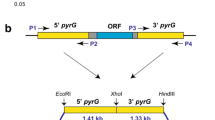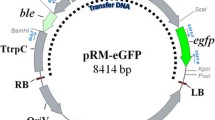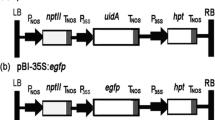Abstract
The filamentous fungus Coleophoma empetri F-11899 produces an echinocandin-like compound FR901379, the original source for micafungin which is prescribed to treat deep-seated mycoses. Despite its industrial importance, no genetic information on C. empetri F-11899 is currently available. To characterize FR901379 biosynthetic genes by insertional mutagenesis and to improve the compound production genetically, Agrobacterium tumefaciens-mediated transformation (ATMT) was attempted to make genetic manipulation possible in this strain. The optimum conditions for ATMT of C. empetri were determined for the cell density of bacteria, time period of co-cultivation and types of filters in co-cultivation. Using the established ATMT method, the hygromycin B resistant gene was successfully transferred into the genome of C. empetri F-11899 and stably maintained even after a serial passage. Some of these results will be applicable for ATMT of various filamentous fungi.




Similar content being viewed by others
References
Betts MF, Tucker SL, Galadima N, Meng Y, Patel G, Li L, Donofrio N, Floyd A, Nolin S, Brown D, Mandel MA, Mitchell TK, Xu JR, Dean RA, Farman ML, Orbach MJ (2007) Development of a high throughput transformation system for insertional mutagenesis in Magnaporthe oryzae. Fungal Genet Biol 44:1035–1049
Cangelosi GA, Ankenbauer RG, Nester EW (1990) Sugars induce the Agrobacterium virulence genes through a periplasmic binding protein and a transmembrane signal protein. Proc Natl Acad Sci USA 87:6708–6712
de Groot MJ, Bundock P, Hooykaas PJ, Beijersbergen AG (1998) Agrobacterium tumefaciens-mediated transformation of filamentous fungi. Nat Biotechnol 16:839–842
Fujie A (2007) Discovery of Micafungin (FK463): a novel antifungal drug derived from a natural product lead. Pure Appl Chem 79:603–614
Garber RC, Yoder OC (1983) Isolation of DNA from filamentous fungi and separation into nuclear, mitochondrial, ribosomal, and plasmid components. Anal Biochem 135:416–422
Godio RP, Fouces R, Gudiña EJ, Martín JF (2004) Agrobacterium tumefaciens-mediated transformation of the antitumor clavaric acid-producing basidiomycete Hypholoma sublateritium. Curr Genet 46:287–294
Hashimoto S (2009) Micafungin: a sulfated echinocandin. J Antibiot (Tokyo) 62:27–35
Idnurm A, Reedy JL, Nussbaum JC, Heitman J (2004) Cryptococcus neoformans virulence gene discovery through insertional mutagenesis. Eukaryot Cell 3:420–429
Iwamoto T, Fujie A, Sakamoto K, Tsurumi Y, Shigematsu N, Yamashita M, Hashimoto S, Okumura M, Kohsaka M (1994a) WF11899A, B and C, novel antifungal lipopeptides, I Taxonomy, fermentation, isolation and physico-chemical properties. J Antibiot (Tokyo) 47:1084–1091
Iwamoto T, Fujie A, Nitta K, Hashimoto S, Okumura M, Kohsaka M (1994b) WF11899A, B and C, novel antifungal lipopeptides, II Biological properties. J Antibiot (Tokyo) 47:1092–1097
Jeon J, Park SY, Chi MH, Choi J, Park J, Rho HS, Kim S, Goh J, Yoo S, Choi J, Park JY, Yi M, Yang S, Kwon MJ, Han SS, Kim BR, Khang CH, Park B, Lim SE, Jung K, Kong S, Karunakaran M, Oh HS, Kim H, Kim S, Park J, Kang S, Choi WB, Kang S, Lee YH (2007) Genome-wide functional analysis of pathogenicity genes in the rice blast fungus. Nat Genet 39:561–565
Li G, Zhou Z, Liu G, Zheng F, He C (2007) Characterization of T-DNA insertion patterns in the genome of rice blast fungus Magnaporthe oryzae. Curr Genet 51:233–243
Meyer V, Mueller D, Strowig T, Stahl U (2003) Comparison of different transformation methods for Aspergillus giganteus. Curr Genet 43:371–377
Michielse CB, Hooykaas PJ, van den Hondel CA, Ram AF (2005) Agrobacterium-mediated transformation as a tool for functional genomics in fungi. Curr Genet 48:1–17
Michielse CB, Hooykaas PJ, van den Hondel CA, Ram AF (2008) Agrobacterium-mediated transformation of the filamentous fungus Aspergillus awamori. Nat Protoc 3:1671–1678
Mullins ED, Chen X, Romaine P, Raina R, Geiser DM, Kang S (2001) Agrobacterium-mediated transformation of Fusarium oxysporum: an efficient tool for insertional mutagenesis and gene transfer. Phytopathology 91:173–180
Park SM, Kim DH (2004) Transformation of a filamentous fungus Cryphonectria parasitica using Agrobacterium tumefaciens. Biotechnol Bioprocess Eng 9:217–222
Rho HS, Kang S, Lee YH (2001) Agrobacterium tumefaciens-mediated transformation of the plant pathogenic fungus, Magnaporthe grisea. Mol Cells 12:407–411
Sambrook J, Russell WD (2001) Molecular cloning: a laboratory manual, 3rd edn. Cold Spring Harbor Laboratory, Cold Spring Harbor, NY
Sugui JA, Chang YC, Kwon-Chung KJ (2005) Agrobacterium tumefaciens-mediated transformation of Aspergillus fumigatus: an efficient tool for insertional mutagenesis and targeted gene disruption. Appl Environ Microbiol 71:1798–1802
Sullivan TD, Rooney PJ, Klein BS (2002) Agrobacterium tumefaciens integrates transfer DNA into single chromosomal sites of dimorphic fungi and yields homokaryotic progeny from multinucleate yeast. Eukaryot Cell 1:895–905
Tzfira T, Citovsky V (2006) Agrobacterium-mediated genetic transformation of plants: biology and biotechnology. Curr Opin Biotechnol 17:147–154
Zhong YH, Wang XL, Wang TH, Jiang Q (2007) Agrobacterium-mediated transformation (AMT) of Trichoderma reesei as an efficient tool for random insertional mutagenesis. Appl Microbiol Biotechnol 73:1348–1354
Acknowledgments
We are grateful to Dr. Kang (Pennsylvania State University, PA, USA), for providing the pBHt2 plasmid. This research was supported by a Grant-in-Aid for Young Scientists (B), (21780079) from The Ministry of Education, Culture, Sports, Science and Technology in Japan (MEXT).
Author information
Authors and Affiliations
Corresponding authors
Additional information
Communicated by J. Heitman.
Rights and permissions
About this article
Cite this article
Yamada, M., Yawata, K., Orino, Y. et al. Agrobacterium tumefaciens-mediated transformation of antifungal lipopeptide producing fungus Coleophoma empetri F-11899. Curr Genet 55, 623–630 (2009). https://doi.org/10.1007/s00294-009-0275-5
Received:
Revised:
Accepted:
Published:
Issue Date:
DOI: https://doi.org/10.1007/s00294-009-0275-5




